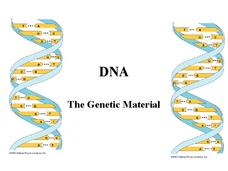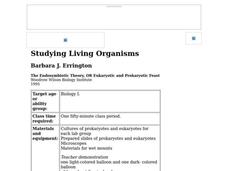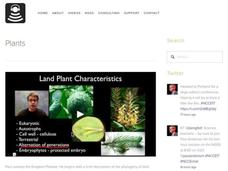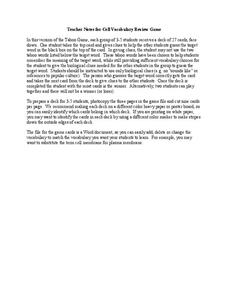Eukarya Teacher Resources
Find Eukarya lesson plans and worksheets
Showing 583 resources
Curated OER
Visualizing Cells
A robotic voice narrates as text and images appear to create a graphic organizer. First, the difference between prokaryotic and eukaryotic cells is described. The plasma membrane, cytoskeleton, nucleus, ribosomes, endoplasmic reticulum,...
Howard Hughes Medical Institute
Regulation of the Lactase Gene
All human infants are lactose tolerant, yet some adults are lactose intolerant—why is that? Individuals discover the process of gene mutation through a study of the lactase gene (LCT). They understand the geographic connections,...
Curated OER
Cell Structures
Learners differentiate between a prokaryotic and eukaryotic cell and give examples of both types. They differentiate between a plant and animal cell. Students will be able to name features common to both as well as unique features of each.
Curated OER
DNA
The question of the structure and function of DNA being the same in almost all organisms is raised here. You will find this PowerPoint a great summary of the building blocks and replication of DNA. The differences between...
Curated OER
Studying Living Organisms
Students are introduced to Hardy-Weinberg Equilibrium without recourse to algebra. After participating in this activity, students gain a feeling for the significance of the Hardy-Weinberg Equilibrium without using algebra.
Curated OER
Cell Me What?
Learners compare and contrast the characteristics of robots and cells. In this biology lesson, students examine the parts and function of cell organelles. They create a visual representation of their cell/robot analogy.
Curated OER
Regulating Gene Expression
In this genes worksheet, students review the system that controls gene expression and the enzymes required for regulating genetic expression. This worksheet has 6 fill in the blank and 7 short answer questions.
Curated OER
Cell Growth and Division
In this biology worksheet, 9th graders identify and explain what cell stay in inter-phase. Then they describe which stage of cell is the shortest and determine why that is true. Students also explain the process of mitosis.
Curated OER
The Six Kingdoms
For this classification worksheet, students complete a chart listing the characteristics of each of six kingdoms. They write definitions for three terms.
Curated OER
What is a Plant?
In this plant worksheet, students will review the origins and adaptations of plants including the alternation of generations. This worksheet has 8 short answer, 6 fill in the blank, and 4 multiple choice questions.
Virginia Department of Education
Classification of Organisms
Searching for the perfect indoor/outdoor activity that allows class members the opportunity to learn about organism classification? Here, pupils research organisms and categorize them according to domain and kingdom over the course...
Odell Education
Plant and Animal Cells
Incorporate multiple facets of the cell into your next high school lab! Through an introduction to cell organelles, class members observe each cell type and draw visuals to further demonstrate understanding of cellular processes in both...
Serendip
Cells as Molecular Factories
Cells are both made of molecules and make molecules all at the same time! An exploratory lesson provides a means for scholars to research the components of cells made of molecules and also investigate the molecule-producing power of...
Biology Junction
Cellular Structure
The human body contains more than 200 types of cells, and plants contain many other unique types of cells. While a huge variety of cells exist, they appear to have very similar structures. A detailed presentation describes the structure...
American Society for Microbiology
”Build a Bacterium” Scavenger Hunt
An exciting activity has scholars use cell parts to build bacteria through cooperation with other groups. Each group has some of the cell parts needed, but they must trade with other groups to be able to fulfill their function as a...
American Museum of Natural History
What do You Know About Life on Earth?
Humans have only inhabited the earth for a fraction of the time that life has existed. Young scientists explore the facts about the emergence of life on Earth with an interactive resource. While highlighting different types of life, the...
Amoeba Sisters
DNA Replication: The Cell's Extreme Team Sport
Hey Ligase, what have you been up to? Just making ends meet. Watch a video that uses cartoon graphics to teach DNA replication in a clear and concise manner. It begins with the where and when, then covers helicase, primase, DNA...
FuseSchool
What is DNA?
Don't under-strand DNA? Watch an informative Fuse School Genetics video to learn what DNA is and where it is found. It also explains what DNA does, its relationship with genes, the four nucleotides, and their base pairs.
Science 4 Inquiry
The Classification of Living Things
It's a classification sensation! Demystify why we classify using an inquiry activity that helps your class sort things out. Groups begin by classifying a variety of shoes before they research organisms and design their own dichotomous...
Howard Hughes Medical Institute
Viral Lysis and Budding
How do some viruses spread so quickly, and why do they make us feel terrible? Answer these (and many more) questions through a simple yet impactful lessons. Pupils observe demonstrations that show the two methods viruses use to escape...
Serendip
Structure and Function of Cells, Organs and Organ Systems
Cells of different organs have unique cell functions. Learn how cell functions vary depending on their roles in the body using an inquiry-based activity. Scholars analyze the cell structure to make comparisons to its functions, allowing...
Crash Course
Old and Odd: Archaea, Bacteria, and Protists
Bacteria outnumber all other living organisms found on Earth. Explore the evolutionary precursor to multicellular organisms, unicellular organisms with a video that delves into the world of bacteria, protists, and archaea and...
Bozeman Science
Plants
Use a biology video to focus on four main groups of plants: bryophytes, ferns, gymnosperms, and anglosperms. It explains the parts of plants, life cyles, evolution of plants, and even touches upon sporophyte and gametophyte.
Serendip
Cell Vocabulary Review Game
Can science scholars describe a nucleus without mentioning DNA, or a chloroplast without mentioning the color green? Test their organelle understanding through an exciting card game. Groups take turns guessing the correct organelle or...

























